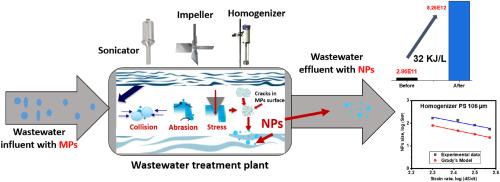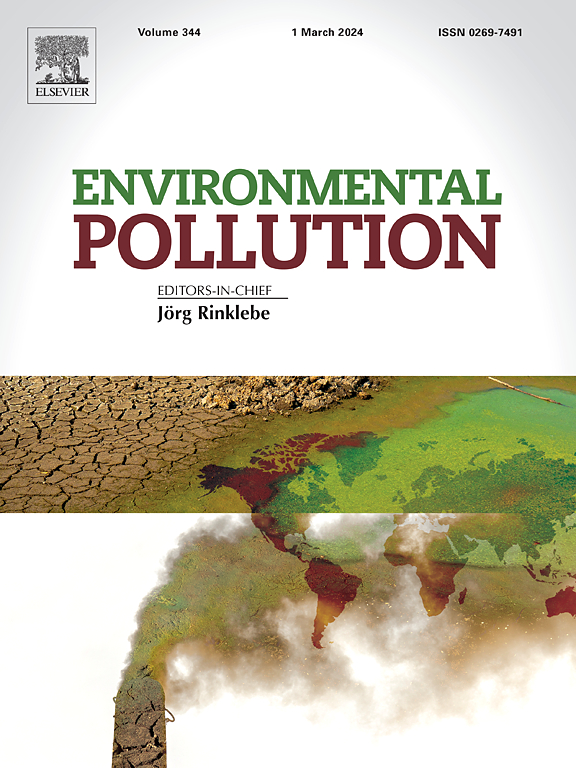Microplastic fragmentation into nanoplastics by water shear forces during wastewater treatment: Mechanical insights and theoretical analysis
IF 7.3
2区 环境科学与生态学
Q1 ENVIRONMENTAL SCIENCES
引用次数: 0
Abstract
Nanoplastics (NPs) are generated from the fragmentation of microplastics (MPs) through mechanical forces such as mixing, sonication and homogenization in wastewater treatment plants (WWTPs). Despite their environmental significance, the formation mechanisms and size distribution of NPs in WWTPs are not well understood. This study presents an in-depth investigation into the fragmentation mechanisms of polyethylene (PE) and polystyrene (PS) MPs, sized 250 μm and 106 μm, under simulated WWTP conditions. Our findings demonstrate that under water shear forces ranging from 32 to 100 kJ/L weathered PS and PE particles were further disintegrated into nano-sized particles. Nanoparticle tracking analysis results revealed a significant increase in NP numbers from 8.34 × 10⁸ to 1.54 × 101⁰ NPs/mL as the water shear force increased from 32 to 100 kJ/L. Notably, the smallest NP, measuring 54.2 nm, was produced from 106 μm PS particles at 100 kJ/L. Scanning electron microscope images confirmed micro-cracks on the particle surfaces as the dominant fragmentation mechanism. A robust correlation between experimental NP sizes and theoretical predictions underscores the continuous production of NPs during water treatment processes. These results offer groundbreaking insights into the transformation of MPs within WWTPs and underscore the urgent need for effective strategies to mitigate NP pollution.


废水处理过程中水的剪切力将微塑料破碎成纳米塑料:力学见解和理论分析。
纳米塑料(NPs)是由微塑料(MPs)在污水处理厂(WWTPs)中通过机械力(如混合、超声和均质化)破碎而产生的。尽管 NPs 对环境具有重要意义,但人们对其在污水处理厂中的形成机制和粒度分布还不甚了解。本研究深入探讨了聚乙烯(PE)和聚苯乙烯(PS)MPs(尺寸分别为 250 μm 和 106 μm)在模拟污水处理厂条件下的破碎机制。我们的研究结果表明,在 32 至 100 kJ/L 的水剪切力作用下,风化的 PS 和 PE 颗粒会进一步分解成纳米级颗粒。纳米粒子跟踪分析结果显示,随着水剪切力从 32 kJ/L 增加到 100 kJ/L,NPs/mL 的数量从 8.34 × 10⁸ 显著增加到 1.54 × 101⁰。值得注意的是,在 100 kJ/L 的剪切力下,106 μm PS 粒子产生了最小的 NP,尺寸为 54.2 nm。扫描电子显微镜图像证实,颗粒表面的微裂缝是主要的破碎机制。实验中的 NP 大小与理论预测之间的紧密相关性强调了在水处理过程中 NP 的持续产生。这些结果为了解污水处理厂内 MPs 的转化提供了突破性的见解,并强调了采取有效策略减轻 NP 污染的迫切需要。
本文章由计算机程序翻译,如有差异,请以英文原文为准。
求助全文
约1分钟内获得全文
求助全文
来源期刊

Environmental Pollution
环境科学-环境科学
CiteScore
16.00
自引率
6.70%
发文量
2082
审稿时长
2.9 months
期刊介绍:
Environmental Pollution is an international peer-reviewed journal that publishes high-quality research papers and review articles covering all aspects of environmental pollution and its impacts on ecosystems and human health.
Subject areas include, but are not limited to:
• Sources and occurrences of pollutants that are clearly defined and measured in environmental compartments, food and food-related items, and human bodies;
• Interlinks between contaminant exposure and biological, ecological, and human health effects, including those of climate change;
• Contaminants of emerging concerns (including but not limited to antibiotic resistant microorganisms or genes, microplastics/nanoplastics, electronic wastes, light, and noise) and/or their biological, ecological, or human health effects;
• Laboratory and field studies on the remediation/mitigation of environmental pollution via new techniques and with clear links to biological, ecological, or human health effects;
• Modeling of pollution processes, patterns, or trends that is of clear environmental and/or human health interest;
• New techniques that measure and examine environmental occurrences, transport, behavior, and effects of pollutants within the environment or the laboratory, provided that they can be clearly used to address problems within regional or global environmental compartments.
 求助内容:
求助内容: 应助结果提醒方式:
应助结果提醒方式:


